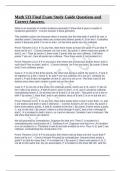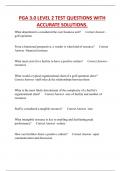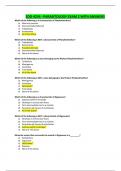Math 533 Final Exam Study Guide Questions and
Correct Answers.
What is an example of a finite incidence geometry? Show that it gives a model of
incidence geometry? - Correct Answer 3 point geometry
This satisfies axiom one because there is exactly one line that both A and B lie one. It
satisfies axiom 2 because there are at least two distinct points A, B on line l. It satisfies
axiom 3 because point C is not on line l, so the three points are non collinear
Prove Theorem 2.6.3: If l is any line, then there exists at least one point P such that P
does not lie on l. - Correct Answer Let l be a line. By axiom 2, there exists two points, R
and S, on l. Then by axiom 3, there exits 3 points that are non collinear. If all other
points T are on l, then all points are collinear. Thus there exists P not incident to l.
Prove Theorem 2.6.4: If P is any point, then there are at least two distinct lines l and m
such that P lies on both l and m. - Correct Answer Let P be any point. By axiom 3 there
exist 3 non collinear points.
Case 1: P is one of the three points, the other two being A and B. By axiom 1, P and A
lie together on a line l. Since A, B, and P are non collinear, B is not on l. Similarly by
axiom 1 P and B also lie together on line m, and A is not on m. The lines l and m are
distinct since they each contain a point not on the other
Case 2: P is not one of the three non collinear points, which are A, B, and C. P lies on
line l with A by axiom 1. If both B and C were on line l, A, B, and C would be collinear
contradicting Axiom 3. So at least one of B and C is not one l. That point is on a line m
with P by axiom 1. Note that l and m are distinct since of B and C is on m but not on l.
Prove Theorem 2.6.5: If l is any line, then there exists lines m and n such that l, m, and
n are distinct and both m and n intersect l. - Correct Answer Let l be a line. By axiom 2
there exits distinct points, A and B, incident to the line l. By axiom 3 there exists a point,
C, not on the line l. By axiom 1 there is a line through A and C and a line n through B
and C. A is incident to both l and m, so l and m intersect. Similarly l and n intersect. We
will show that lemon are distinct.
We will proceed by contradiction. Suppose firs that m=l. Then C is incident to l,
contradicting the construction of C. Similarly if n=l. Suppose now that m=n. An incident
to m so incident to n. Therefore A and B are both incident to m=n. Thus A, B, and C are
collinear, contradicting the construction of C.
Prove Theorem 2.6.6: If P is any point, then there exits at least one line l such that P
does not lie on l. - Correct Answer Proceed by contradiction. Assume there exists a
point P so that for every line l, P is incident to l. By axiom 3, there exist points A, B, C
not all on the same line. By our assumption, P is incident to the lines AB, BC, and AC.
, Hence, lines PA = PB, but PA=AC=PC. Thus A, B, C are all incident to line PA. This
contradicts the fact A, B, C not all on the same line.
Prove Theorem 2.6.7: There exist three distinct lines such that no point lies on all three
of the lines. - Correct Answer By axiom 3 there are three non collinear points A, B, and
C. By axiom 1 A and B lie together on l. Similarly B and C lie together on m, and A and
C lie together on n. Now suppose for contradiction that there were a point P common to
all three lines. Then P would be collinear with A and B (on l), and also P would be
collinear with A and C (line n). But since there is only one line common to points A and
P, it must be that lines l and n are the same line, forcing A, B, and C to be collinear, a
contradiction. So no such point P can exist
Prove Theorem 2.6.8: If P is any point, then there exist points Q and R such that P, Q,
and R are non collinear. - Correct Answer Let p be a point. By a previously proved
theorem we know that there is a line l such that P is not on l. By axiom 2, we know l has
two distinct points, Q and R. Since P isn't on l and there is only one line, l, containing Q
and R. Thus P, Q, and R are non collinear since P doesn't lie on l.
Prove Theorem 2.6.9: If P and Q are two points such that P and Q are non equal, then
there exits a point R such that P, Q, and R are non collinear. - Correct Answer Let P
and Q be any two points. By Axiom 1, P and Q lie together on line l. By a previous
theorem, there is a point R not on that line. Since l is the only line containing both P and
Q (Axiom 1) and R is not on it, P, Q, and R are non collinear.
What does it mean to say a set is convex? - Correct Answer If for every pair of points A
and B in S, the entire segment AB is contained in S
Show that the intersection of two convex sets is convex - Correct Answer Let A,B ∈
S1∩S2. S1 is convex so segment AB is a subset of S1. Same with S2. So segment AB
is a subset of S1∩S2. Thus S1∩S2 is convex
What does it mean to say that the point B is between points A and C? - Correct Answer
AC=AB+BC
B is not equal to A or C
A,B,C are collinear
What is the definition of a segment AB? - Correct Answer AB = {A}U{P | A * P * B}U{B}
Prove the existence and uniqueness of midpoints. - Correct Answer Existence: Let l =
↔AB and f:l→R be a coordinate function on l, hence 1-1, onto, and AB=|f(A)-f(B)|.
t=(f(A)+f(B))/2
Since f is onto, there exists a point m∈l such that f(m)=t. Thus, m is between A and B by
betweenness theorem for points
-AM=|f(A)-f(M)| = |f(A)-((f(A)+f(B))/2)| = |2f(A)-f(A)+f(b) / 2| = |f(A)-f(B)/2|
-MB=|f(M)-f(B)| = |((f(A)+f(B))/2) - f(B)| = |f(A)-f(B)/2|






